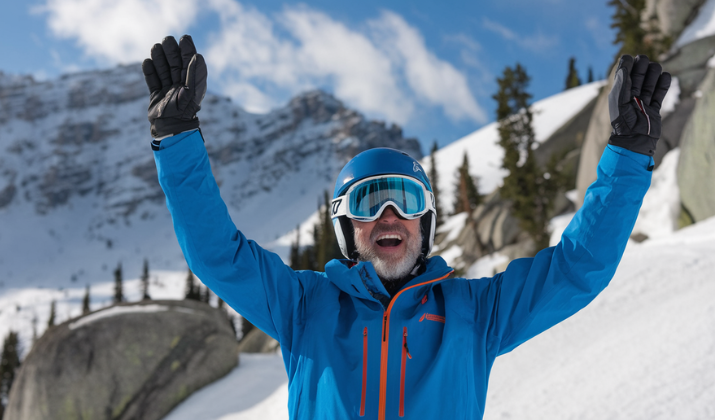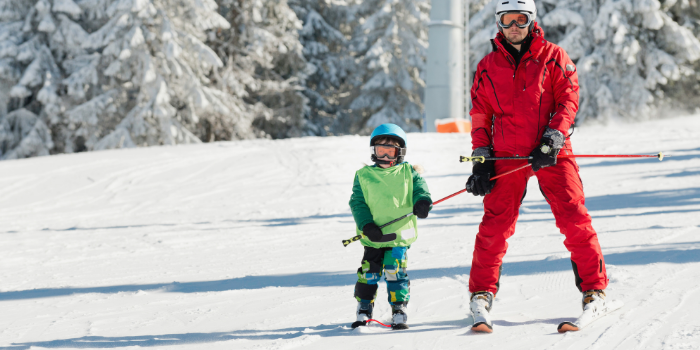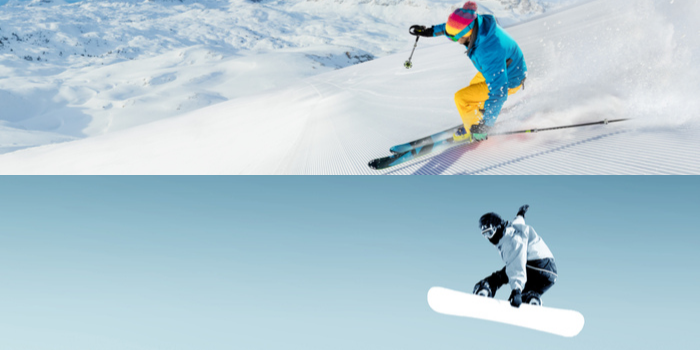Alpine skiing captivates audiences worldwide with its perfect blend of speed, technique, and courage.
Among the various disciplines, Downhill and Super G (Super Giant Slalom) stand out as the fastest and most thrilling events in competitive skiing.
While casual viewers might struggle to differentiate between these two speed events, they feature distinct characteristics that influence everything from course design to skiing technique.
This comprehensive guide explores the nuanced differences between Downhill and Super G, offering insights for both newcomers to the sport and seasoned skiing enthusiasts looking to deepen their understanding of these exhilarating alpine competitions.
Let’s get started.
Also Read: Different Types of Downhill Skis
Historical Development
The Downhill discipline has deeper historical roots in competitive skiing, dating back to the early 20th century.
It emerged as one of the original alpine events, embodying the pure essence of speed skiing. The first official Downhill races were held in the 1920s, and the event has been a staple of the Winter Olympics since 1948.
Super G, by contrast, is a relatively newer addition to the competitive skiing landscape. Introduced in the 1980s as a middle ground between the technical precision of Giant Slalom and the raw speed of Downhill, Super G made its Olympic debut at the 1988 Calgary Games.
The discipline was created to challenge skiers with a combination of speed and technical turning ability, offering a different test of skiing versatility that neither pure Downhill nor Giant Slalom could provide.
Course Setup and Design
Downhill courses are designed primarily for maximum speed, featuring longer tracks that typically range from 2,500 to 3,500 meters for men and 1,700 to 2,500 meters for women.
These courses incorporate natural terrain features with steep sections that can exceed 45-degree gradients, creating dramatic drops and jumps where skiers can become airborne for significant distances.
Course designers set fewer gates in Downhill—typically only enough to control speed in certain sections or to guide skiers through particular terrain features.
The overall emphasis remains on allowing skiers to achieve their maximum velocity while navigating the mountain’s natural contours.
Super G courses, while still focused on speed, are shorter than Downhill tracks, usually measuring between 1,500 to 2,200 meters for men and 1,300 to 2,000 meters for women.
They incorporate more gates than Downhill courses—approximately 35 to 40 gates for men and slightly fewer for women—creating a more technical challenge that requires additional turning skills.
These gates are set further apart than in technical events like Slalom or Giant Slalom but closer together than in Downhill, forcing skiers to make more tactical decisions while maintaining high speeds.
Check Out: Types of Skiing
Speed and Technical Elements
Downhill is universally recognized as the fastest alpine skiing discipline, with elite competitors regularly reaching speeds exceeding 130 kilometers per hour (80 mph), and occasionally approaching 160 km/h (100 mph) on particularly steep sections.
The primary technical focus in Downhill is on aerodynamic positioning, line selection, and the courage to maintain maximum speed through challenging terrain.
Skiers adopt an egg-shaped tuck position to minimize wind resistance, making minute adjustments to maintain balance while absorbing terrain changes at extraordinary speeds.
The Super G, while still incredibly fast with speeds regularly exceeding 100 km/h (62 mph), generally produces velocities about 10-15% lower than Downhill.
What Super G sacrifices in raw speed, it compensates for in technical complexity. Skiers must combine speed techniques with turning skills, requiring greater agility and adaptability.
The increased number of gates demands more turning precision while still maintaining high velocity, creating a unique challenge that tests a broader range of skiing abilities than the pure speed focus of Downhill.
Also Read: Inspirational Skiing Quotes
Equipment Specifications
Equipment differences between the two disciplines reflect their distinct technical demands.
Downhill skis are the longest used in alpine competition, typically measuring between 210-225 cm for men and 200-215 cm for women.
This length provides stability at extreme speeds but sacrifices maneuverability. Downhill skis feature a more gradual sidecut (the difference between the width at the tip, waist, and tail), making them less conducive to sharp turns but more stable in a straight line.
Super G skis are slightly shorter, usually between 205-220 cm for men and 195-210 cm for women, offering a compromise between the stability needed for speed and the maneuverability required for turning.
They have a more pronounced sidecut than Downhill skis, allowing for more controlled turns while still maintaining stability at high speeds.
Both disciplines require specialized safety equipment, including reinforced helmets, back protectors, and padded suits, though Downhill’s higher speeds often lead to more comprehensive protection requirements.
Also Read: Giant Slalom vs Slalom
Training and Preparation
The training regimens for Downhill and Super G reflect the unique demands of each discipline.
Downhill training emphasizes extended conditioning for sustained speed sections, with athletes developing exceptional leg strength and endurance to withstand the prolonged strain of longer courses.
Mental preparation is particularly crucial for Downhill specialists, who must overcome natural fear responses when traveling at extreme speeds with minimal protection.
Training often includes extensive course inspection and memorization, as Downhill courses have fewer gates but more subtle terrain features to navigate.
Super G training balances speed conditioning with technical turning practice, requiring athletes to develop both the power needed for velocity and the agility necessary for more frequent directional changes.
While still demanding considerable mental fortitude, Super G allows slightly more reaction time than Downhill due to the somewhat reduced speeds.
Training frequently incorporates elements from both Giant Slalom practice (for turning technique) and Downhill preparation (for speed adaptation), reflecting the hybrid nature of the event.
Competition Format
Downhill competitions follow a straightforward format where each competitor takes a single run down the course, with the fastest time determining the winner.
Unlike technical events, Downhill features official training runs in the days leading up to competition, allowing skiers to familiarize themselves with the course at racing speeds before the actual event.
This practice is essential for safety given the extreme velocities involved.
Super G competitions also utilize a single-run format with the fastest time winning, but unlike Downhill, they typically do not include official training runs on the actual competition course.
Instead, skiers only get a course inspection where they can side-slip or slowly ski sections to memorize gate placements and terrain features.
This creates an additional challenge, as competitors must execute their race runs without having previously experienced the course at full speed, placing greater emphasis on adaptability and quick decision-making.
Explore: Types of Ski Races
Risk and Safety Considerations
Both disciplines rank among the most dangerous in alpine skiing, but they present different risk profiles.
Downhill features the highest injury rates in alpine skiing due to its extreme speeds and the significant air time skiers experience over jumps.
Crashes at Downhill velocities can result in severe injuries, leading to the implementation of extensive safety measures including multiple layers of safety netting, padded course features, and strict equipment regulations.
The longer courses also mean sustained physical exertion, increasing fatigue-related risks toward the end of runs. Super G presents a different safety challenge, combining high speeds with more frequent turning requirements.
While speeds are somewhat lower than in Downhill, the technical elements can create unpredictable crash scenarios, particularly when skiers misjudge a turn at high velocity.
The additional gates also mean more potential impact points if a skier loses control. Both disciplines have driven significant advancements in skiing safety technology, from course design improvements to innovations in protective equipment.
Career Specialization and Cross-Discipline Performance
While many elite skiers compete in both Downhill and Super G, athlete physiology and skill sets often lead to specialization.
Downhill specialists typically have powerful builds with exceptional leg strength and mental fortitude to handle the purest speed challenges.
They excel at aerodynamic positioning and reading subtle terrain changes at extreme velocities. These athletes often struggle more with technical events that require rapid direction changes and quick edge transitions.
Super G specialists frequently demonstrate more versatility across alpine disciplines, as the event’s hybrid nature rewards adaptable skiers who can balance speed with technical proficiency.
Many successful Super G competitors also perform well in Giant Slalom or even Downhill, making it something of a bridge discipline.
The all-around skiers who excel in the overall World Cup standings typically perform strongly in Super G, as it rewards the broadest range of skiing abilities.
Check Out: Ski Slope Levels – A Guide
Spectator Experience and Broadcast Considerations
The viewer experience differs substantially between the two events.
Downhill competitions deliver pure adrenaline and spectacle, with the extended course length creating a longer viewing experience for each competitor—typically between 1:45 to 2:30 minutes per run for men and slightly less for women.
The extreme speeds and dramatic jumps make for visually striking television, with broadcasters often employing speed trackers and slow-motion replays to highlight the incredible velocities.
Super G offers a more technically nuanced viewing experience while still showcasing impressive speed. Runs typically last between 1:15 to 1:45 minutes for men and slightly less for women.
Television coverage often focuses on the technical aspects of navigating gates at high speed, with analysis frequently highlighting the turning technique in addition to pure speed segments.
Both events create compelling viewing, but Downhill tends to attract casual viewers with its pure speed appeal, while Super G often engages those with a deeper appreciation for skiing technique.
Also Read: Best Skiing Documentaries
Conclusion
The differences between Downhill and Super G represent more than just variations in speed and course design. They reflect two distinct philosophies within alpine skiing.
Downhill embodies the purest expression of speed and courage, challenging athletes to push the boundaries of velocity while maintaining control through natural terrain.
Super G represents a balanced approach that tests a skier’s complete arsenal of skills, demanding both the bravery required for speed disciplines and the technical finesse associated with slalom events.
Understanding these differences enhances appreciation for both disciplines and the remarkable athletes who master them.













